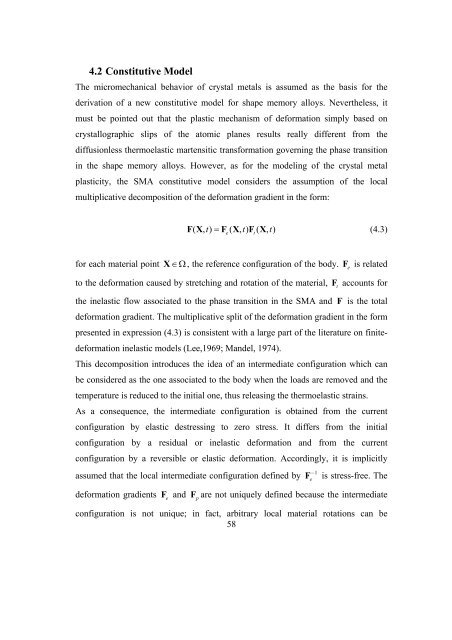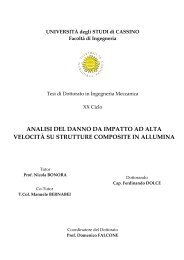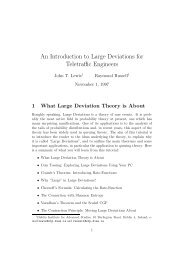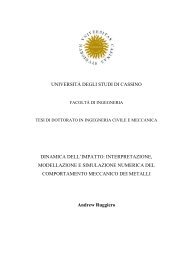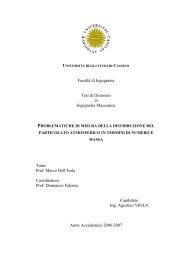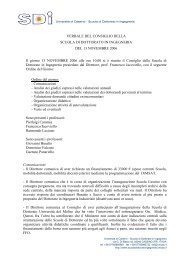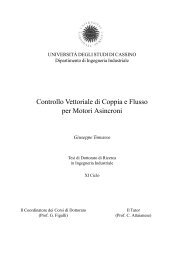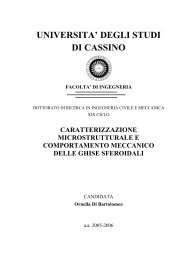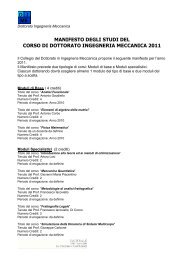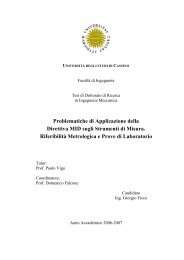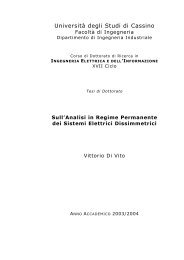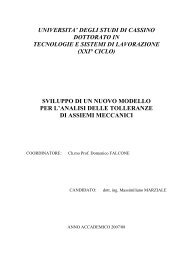Finite Strain Shape Memory Alloys Modeling - Scuola di Dottorato in ...
Finite Strain Shape Memory Alloys Modeling - Scuola di Dottorato in ...
Finite Strain Shape Memory Alloys Modeling - Scuola di Dottorato in ...
Create successful ePaper yourself
Turn your PDF publications into a flip-book with our unique Google optimized e-Paper software.
4.2 Constitutive ModelThe micromechanical behavior of crystal metals is assumed as the basis for thederivation of a new constitutive model for shape memory alloys. Nevertheless, itmust be po<strong>in</strong>ted out that the plastic mechanism of deformation simply based oncrystallographic slips of the atomic planes results really <strong>di</strong>fferent from the<strong>di</strong>ffusionless thermoelastic martensitic transformation govern<strong>in</strong>g the phase transition<strong>in</strong> the shape memory alloys. However, as for the model<strong>in</strong>g of the crystal metalplasticity, the SMA constitutive model considers the assumption of the localmultiplicative decomposition of the deformation gra<strong>di</strong>ent <strong>in</strong> the form:FX ( , t) = F( X, t) F( X , t)(4.3)etfor each material po<strong>in</strong>tX ∈Ω, the reference configuration of the body. Feis relatedto the deformation caused by stretch<strong>in</strong>g and rotation of the material, Ftaccounts forthe <strong>in</strong>elastic flow associated to the phase transition <strong>in</strong> the SMA and F is the totaldeformation gra<strong>di</strong>ent. The multiplicative split of the deformation gra<strong>di</strong>ent <strong>in</strong> the formpresented <strong>in</strong> expression (4.3) is consistent with a large part of the literature on f<strong>in</strong>itedeformation<strong>in</strong>elastic models (Lee,1969; Mandel, 1974).This decomposition <strong>in</strong>troduces the idea of an <strong>in</strong>terme<strong>di</strong>ate configuration which canbe considered as the one associated to the body when the loads are removed and thetemperature is reduced to the <strong>in</strong>itial one, thus releas<strong>in</strong>g the thermoelastic stra<strong>in</strong>s.As a consequence, the <strong>in</strong>terme<strong>di</strong>ate configuration is obta<strong>in</strong>ed from the currentconfiguration by elastic destress<strong>in</strong>g to zero stress. It <strong>di</strong>ffers from the <strong>in</strong>itialconfiguration by a residual or <strong>in</strong>elastic deformation and from the currentconfiguration by a reversible or elastic deformation. Accor<strong>di</strong>ngly, it is implicitlyassumed that the local <strong>in</strong>terme<strong>di</strong>ate configuration def<strong>in</strong>ed bydeformation gra<strong>di</strong>ents F eandF is stress-free. Theconfiguration is not unique; <strong>in</strong> fact, arbitrary local material rotations can be58−1eFpare not uniquely def<strong>in</strong>ed because the <strong>in</strong>terme<strong>di</strong>ate


